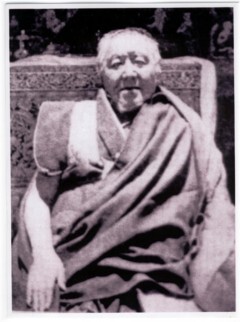Brief Commentary on the Refuge & Bodhichitta Prayer
A Brief Commentary on the Refuge & Bodhicitta Prayer known as Sangyé Chö Tsok Ma
by Dzatrul Ngawang Tenzin Norbu
I. Taking Refuge
1. The Objects of Refuge
If we elaborate upon the Sangyé Chö Tsok Ma prayer, the first line (“In the Buddha, Dharma and the Supreme Assembly,”) reveals the objects of refuge, the Three Jewels.
The Three Jewels are:
- The unsurpassable teacher, the perfect Buddha
- The unsurpassable protection, the sacred Dharma
- The unsurpassable guides, the noble Saṅgha
1. Buddha
The teacher, the perfect Buddha (Tib. sang-gyé) comprises the four kāyas and the five wisdoms. Here ‘awakened’ (sang) refers to the support, the four kāyas, and ‘unfolded’ (gyé) to the supported, the five wisdoms. Since the ultimate awakening is the dharmakāya and the ultimate unfolding is primordial wisdom, this is the Jewel of Buddha (or ‘awakening and unfolding’).
2. Dharma
The sacred Dharma consists of the Dharma of transmission and realization. Transmission refers to the threefold collection (Skt. tripiṭaka):
- The vinaya (Tib. dülwa) collection through which we tame (dülwa) all destructive emotions,
- the sūtra (Tib. do dé) collection consisting of concise (do) discourses arranged into categories (dé), and
- the abhidharma (Tib. ngönpa) collection which engenders wisdom (Skt. prajñā), through which we can directly (ngön sum du) realize the way things are.
The vinaya teaches the training in superior ethical discipline, the sūtras teach the training in superior meditation, and the abhidharma teaches training in superior wisdom. By practising these three trainings, we are led to true liberation. So the Jewel of the Dharma consists of two truths: the truth of cessation, which is perfect elimination, and the truth of the path, which is perfect realization.
3. Saṅgha
The Saṅgha, the Supreme Assembly, is comprised of non-regressing bodhisattvas. Bodhisattvas abiding on the ten bhūmis do not fall back into samsara because they have realized emptiness directly through wisdom. Nor do they fall into the extreme of quiescence, since in their compassion they regard all beings as lovingly as if each were their only child. This is the saṅgha of the great āryas.
In addition, although they are not actual sources of refuge, there are the semblances of such sources: images of the buddhas which in physical form, the buddhas’ words appearing in the form of letters, and all those who have entered the teachings, and, since they are nobler than ordinary individuals, are said to belong to the noble saṅgha.
These were the objects of refuge.
2. Causal & Resultant Refuge
The next line is: “I take refuge until I attain enlightenment.” With this we state our intention, along with all other beings, in a single voice. Before the sources of refuge, the Three Precious Jewels, we adopt the basis of training, which is the mahāyāna attitude of ‘shepherd-like’ or incomparable bodhicitta,[1] and we declare that from now until we attain the essence of enlightenment, all of us who are tormented by the unbearable sufferings of saṃsāra, and all its entanglements, have no other refuge or hope but you. From the depths of our hearts, therefore, we take refuge in you, in the knowledge that you will never fail us. This is the causal refuge.
The resultant refuge is the recognition of a state that is the ultimate essence of the refuge objects, the dharmakāya, which is beyond arising and ceasing, in which we neither focus on any object of refuge nor conceive of one who takes refuge.
II. Arousing Bodhicitta
This consists of both relative and absolute bodhicitta.
1. Relative Bodhicitta
Relative bodhicitta includes bodhicitta in aspiration, which is the wish that all beings, including ourselves, might attain buddhahood, and bodhicitta in action, which involves applying ourselves directly to the methods for attaining buddhahood, the bodhisattvas’ actions.
The bodhicitta of aspiration includes (i) aspiring to the cause, which is merit, and (ii) aspiring to the result, perfect buddhahood.
The first is expressed in the next line: “Through the merit of practising generosity and so on.”
All sources of virtue gained through our practices of generosity and so on, may be included within the three merit-producing factors. There is (i) merit born of generosity, (ii) merit born of ethical discipline, and (iii) merit born of meditation. Generosity and ethical discipline are stated directly, and meditation refers to the merit gained through the strength of cultivating patience, meditative concentration and wisdom. Diligence supports them all.
Secondly, there is aspiring to perfect enlightenment. In this, the phrase “for the benefit of all beings” indicates focusing on sentient beings with compassion. It shows why we are working towards our particular objective, in order to benefit all living beings. The phrase “May I attain Buddhahood” shows the particular objective that we working towards for the sake of these sentient beings. In other words, it is focusing on complete enlightenment with wisdom, the wish that we might swiftly attain buddhahood.
2. Absolute Bodhicitta
Absolute bodhicitta is to rest in a state which is beyond a mind to be generated or one who generates it, arrived at through an undeluded comprehension that the essence of our own and all beings’ mindstreams has always been enlightened as the buddha nature (Skt. sugatagarbha), and through realizing the wisdom that brings certainty, utterly purified of the three conceptual spheres.[2]
This commentary on the words of the prayer known as ‘Sangyé Chö Tsok Ma’, was composed by Dzatrul, merely to provide a framework.[3] May virtue and goodness abound!
| Translated by Adam Pearcey, 2009. With thanks to Khenpo Dawa Paljor for his clarifications.
Version: 1.2-20240826
